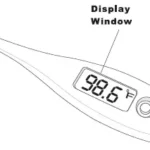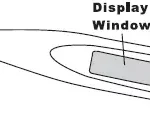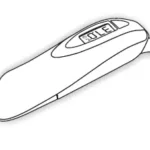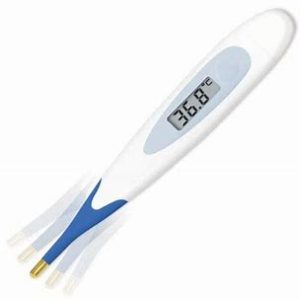
Digital Clinical Thermometer
KD-133
INSTRUCTIONS FOR USE
Please read carefully before using
FEATURES
- Easy to read digital LCD ( liquid crystal display ).
- Compact, accurate and durable LSI ( large scale integration ) device.
- Temperatures can be taken under the tongue ( oral use ) or under the arm ( axillary use ). It is suggested that rectal temperatures be taken on infants only when axillary use is inconvenient.
- Very sensitive device, quick to obtain results.
- If the thermometer is inadvertently left on after temperature stabilization, it will automatically shut off in about 3 minutes.
- Small , light weight unit ( 11 grams ). Universal use for the whole family. Especially ideal for children.
- ABS resin body presents no hazard compared to broken mercury glass thermometers .
- Low battery indicator: when the symbol appears, the battery needs to be replaced.
- The unit is water resistant.
PARTS DESCRIPTION
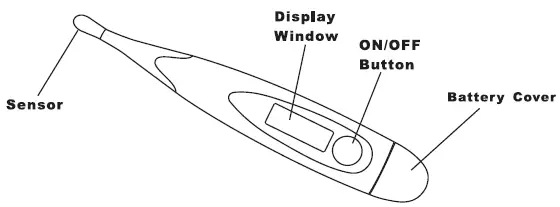
SPECIFICATIONS
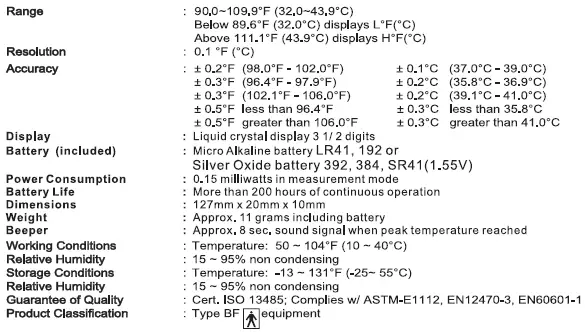
PRECAUTIONS
- Do not boil the probe . Instead , clean the unit by wiping it with a dry cloth and disinfect the probe with isopropyl ( rubbing ) alcohol .
- Do not drop the thermometer or expose it to heavy shock . The unit is not shock-proof .
- Do not bend or bite the probe .
- Do not store the unit under direct sunlight , at a high temperature , in high humidity or dust. Performance may be degraded.
- Stop using the thermometer if it operates erratically or if the display malfunctions .
- Keep out of reach of unsupervised children .
- Clean the thermometer probe before storing .
- Do not attempt to disassemble the unit except to replace the battery .
- If the thermometer has been stored at below-freezing temperatures, allow the thermometer to warm naturally to room temperature before using .
- Performance of the device may be degraded if : Operated or stored outside stated temperature and humidity ranges or if the patient’s temperature is below the ambient(room) temperature
BATTERY REPLACEMENT
- When the symbol “BATTERY ” appears , the battery needs to be replaced.
- Pull the battery cover off in the direction shown.
- If necessary, use a pointed object such as a toothpick or insulated probe to pry loose the battery cover and the old battery. Avoid using any sharp metal object in this operation.
- Clean the battery contacts and also those of the device prior to battery re-installation.
- Place a new 1.55 VDC button size battery type Micro Alkaline battery LR41, 192 or Silver Oxide battery 392, 384, SR41 or equivalent in the chamber with the negative (-) side up and the positive (+) side down .
- Replace and fasten the battery cover securely.
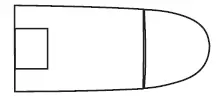
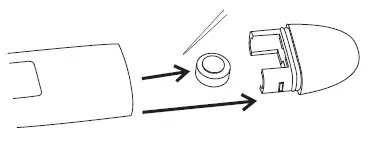
Warning : Discard old battery carefully, out of reach of young children. Swallowing the battery may be fatal. lithe battery Is swallowed, contact hospital Immediately to have It removed. Do not dispose of the battery in a fire. It may explode.
HOW TO USE
1.Disinfect the probe with rubbing alcohol before using.
2. Depress the on/off button. The display will read

3. Release the power switch and the display will show L °Forl2Cwith °F or °C flashing.
4. Place the probe in the appropriate position (oral, axillary or rectal).
5. Once the degree sign°F (°C)on the display has stopped flashing (usually within 40-120 seconds ) the measured temperature is indicated.
6. The unit will automatically turn off in 3 minutes ( approx. ). However, to prolong battery life, it is best to turn off the thermometer once the temperature has been noted.
Special Features:
Normal Temperature Alarm: An alarm will sound when the peak temperature has registered and is ready-to -read.The “Normal Temperature” alarm (four quick beeps followed by a pause) will sound repeatedly for approximately 8 seconds.
Last-Temperature Memory Recall: When the ON/OFF button is depressed to activate the thermometer, hold down for approximately 5 seconds. The display of 188.8 will change to show the last measured temperature. This reading is displayed as long as the button is held down. When the button is released, the thermometer will be in “ready-to-measure” mode and the recalled temperature will be erased.
For Models with Fever Alarm : If the temperature registers higher than 99.5°F(37.5°C), the fever alarm (a quick beeping sound which occurs continuously for about 10 seconds) will sound when the peak temperature has registered.
To change the scale from Fahrenheit (°F) to Centigrade (°C): After turning the thermometer on, immediately press the ON/OFF button again and release. The °F changes to a °C. Once the display shows an L with a flashing °F or °C, the device is ready to record and display a temperature. Follow the same directions to switch back from Centigrade to Fahrenheit.
NOTE: Always disinfect the thermometer before using.
NOTE: In Step 2, if the room temperature is greater than 90.0°F (32.0°C), it will be displayed rather than L°F(L°C).
NOTE: In Step 3, you may put a sanitary plastic probe shield on the sensor tip to help prevent cross-infection and contamination. Use of the probe cover may result in a 0.2°F(0.1°C) difference from actual temperature. Dispose of any used probe shield and store the unit in a safe place.
RELIABLE METHODS TO MEASURE TEMPERATURE
THE TAKING OF BODY TEMPERATURES: Change in body temperature is one of the most important indicators of illness. It is important that accurate temperatures be taken. Even though the digital thermometer is used in similar manner to the glass thermometer, it is Important that the simple instructions for use of this thermometer be followed closely and that the person taking the temperature understands body temperature.
BODY TEMPERATURE: A person’s body temperature will usually be several tenths to one full degree lower in the morning than it is in the late afternoon. Therefore, if your temperature is 97.9°F(36.6°C) in the morning, it could be 98.4°F(36.9°C) or more in the late afternoon and still be normal. To determine what your normal body temperature is you should take your temperature both in the early morning and in the late afternoon over several days. Children have the same normal temperature range as do adults. A fever for both children and adults is typically defined as a temperature over 99.5°F(37.5°C) (oral reading). Exercise, excessive clothing, hot bath, hot weather, warm food and drink can cause mile elevations of up to 100.4°F(38°C) to 101.2°F(38.4°C) in oral temperature. If you suspect one of these to be the cause of an elevated reading, eliminate the possible cause and retake the temperature in a half hour.
ORAL USE
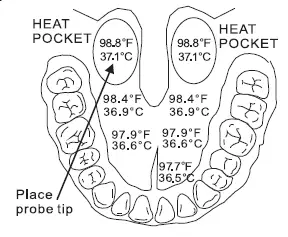
Place the probe well under the patient’s tongue. Instruct the patient to keep their mouth closed while the thermometer is reading. A normal temperature by this method is usually considered between 96.8°F to 98.6°F(36.0°C to 37.5°C).
RECTAL USE
If rectal temperature is recommended by your doctor, you may use a probe shield. Insert thermometer into the probe shield. Lubricate the probe cover with a water soluble jelly for easier insertion . Do not use petroleum jelly . Insert tip of probe no more than 1/2 inch into rectum . STOP if you meet any resistance . The sensing unit is on the very tip of the probe and there is no need to insert the probe deep into the rectum . In general, the rectal temperature is around 1.0 to 2.0°F(0.5°C to 1.0°C) higher than oral temperature.
AXILLARY USE
Wipe armpit with a dry towel . Place probe in the patient’s armpit and keep the patient’s arm pressed firmly against the body. In general, the axillary temperature is around 1.0 to 2.0°F(0.5°C to 1.0°C) lower than oral temperature. Note that in order to achieve better axillary temperature measurement result a minimum measuring time of 2-3minutes is recommended regardless of the been sound.
NOTE : Children should be attended by an adult during the entire temperature recording process . After use , the digital thermometer should be stored in a safe place, out of reach of young children. If you compare temperatures between two thermometers , it is possible to have two different readings even if bath thermometers are within their accuracy tolerances. Differences in how you take each reading and the thermometer’s tolerance range can account for nearly 0.2°F(0.1 °C) variability.
CLEANING INSTRUCTIONS
To clean the thermometer, wash the tip with a solution of mild detergent and cool water. The thermometer can also be disinfected by one of the methods below. Note that you must allow the thermometer to dry completely before use.

LIMITED WARRANTY
This thermometer has a Lifetime Warranty against manufacturer’s defect under normal, household use. Follow the directions closely will ensure years of dependable operation.
If the thermometer does not function properly, first check the battery (see battery replacement instructions). Replace it if necessary.
FCC STATEMENT
NOTE: POTENTIAL FOR RADIO/TELEVSION INTERFERENCE (for U.S.A. Only)
Operation is subject to the following two conditions: 1)This device may not cause harmful interference, and 2) this device must accept any interference received, including interference that may cause undesired operation.
This product has been tested and found to comply with the limits for a Class B digital device, pursuant to part 15 of the FCC rules.
These limits are designed to provide reasonable protection against harmful interference in a residential installation.The product generates, uses, and can radiate radio frequency energy and, if not installed and used in accordance with the instructions, may cause harmful interference to radio communications. However, there is no guarantee that interference will not occur in a particular installation. If the product does cause harmful interference to radio or television reception, which can be determined by turning the product on and off, the user is encouraged to try to correct the interference by one or more of the following measures:
*Reorient or relocate the receiving antenna
*Increase the separation between the product and the receiver.
*Consult the dealer or an experienced radio/TV technician for help.
Changes or modifications not expressly approved by the party responsible for compliance could void the user’s authority to operate the equipment.

